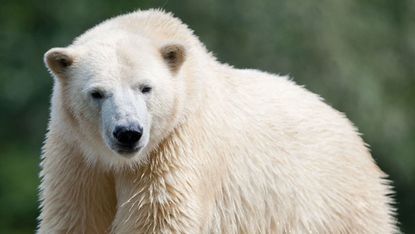No DNA evidence for Yetis - but polar bears 'found in India'
Tests on samples of hair from all over the world rule out existence of 'anomalous primates'

A major scientific attempt to prove the existence of 'anomalous primates' - those elusive beasts known around the world as yeti, sasquatch, bigfoot, almasty or migyur - has uncovered tantalising evidence of an undiscovered type of bear.
Brian Sykes, a professor of human genetics at Oxford, wrote to museums and collectors around the world seeking yeti or other mysterious hair samples to test the theory that persistent tales of mountain men could mean that Neanderthals had survived into the modern era, says The Guardian.
He received samples from all over the world - but, sadly, DNA testing found none was a match for early hominids. Instead, the hairs he received belonged to animals including cows, raccoons, horses, dogs, sheep, a Malayan tapir and a porcupine.
Subscribe to The Week
Escape your echo chamber. Get the facts behind the news, plus analysis from multiple perspectives.

Sign up for The Week's Free Newsletters
From our morning news briefing to a weekly Good News Newsletter, get the best of The Week delivered directly to your inbox.
From our morning news briefing to a weekly Good News Newsletter, get the best of The Week delivered directly to your inbox.
One sample from Texas was a modern human hair and Sykes was also sent a blade of grass and a strand of fibreglass. He points out that, of course, just because none of the samples were from primates doesn't prove that yetis don't exist.
The study threw up two entirely unexpected results, however. Two samples of fur, one from Bhutan and one from Ladakh in the Indian Himalayas, showed a precise match to DNA extracted from fossil remains of a type of polar bear which lived 40,000 years ago.
The samples are quite different from modern polar bear DNA, raising the intriguing possibility that descendants of a prehistoric polar bear are alive and at large in the Himalayas. The Indian fur is said to come from the pelt of an animal shot 40 years ago by a hunter.
The two samples which match the fossil DNA are not coloured like a modern polar bear - one is reddish-brown and the other golden-brown. The Ladakh hunter said the bear's behaviour was very different from that of a normal brown bear, however.
Sykes said: "Polar bears have some quite distinct behaviour, including deliberately hunting human prey. It would be very interesting to go and see if this is a behavioural pattern which has endured in the Himalayan bears."
Create an account with the same email registered to your subscription to unlock access.
Sign up for Today's Best Articles in your inbox
A free daily email with the biggest news stories of the day – and the best features from TheWeek.com
-
 'Voters know Biden and Trump all too well'
'Voters know Biden and Trump all too well'Instant Opinion Opinion, comment and editorials of the day
By Harold Maass, The Week US Published
-
 Is the Gaza war tearing US university campuses apart?
Is the Gaza war tearing US university campuses apart?Today's Big Question Protests at Columbia University, other institutions, pit free speech against student safety
By Joel Mathis, The Week US Published
-
 DOJ settles with Nassar victims for $138M
DOJ settles with Nassar victims for $138MSpeed Read The settlement includes 139 sexual abuse victims of the former USA Gymnastics doctor
By Justin Klawans, The Week US Published
-
 Home Office worker accused of spiking mistress’s drink with abortion drug
Home Office worker accused of spiking mistress’s drink with abortion drugSpeed Read Darren Burke had failed to convince his girlfriend to terminate pregnancy
By The Week Staff Published
-
 In hock to Moscow: exploring Germany’s woeful energy policy
In hock to Moscow: exploring Germany’s woeful energy policySpeed Read Don’t expect Berlin to wean itself off Russian gas any time soon
By The Week Staff Published
-
 Were Covid restrictions dropped too soon?
Were Covid restrictions dropped too soon?Speed Read ‘Living with Covid’ is already proving problematic – just look at the travel chaos this week
By The Week Staff Last updated
-
 Inclusive Britain: a new strategy for tackling racism in the UK
Inclusive Britain: a new strategy for tackling racism in the UKSpeed Read Government has revealed action plan setting out 74 steps that ministers will take
By The Week Staff Published
-
 Sandy Hook families vs. Remington: a small victory over the gunmakers
Sandy Hook families vs. Remington: a small victory over the gunmakersSpeed Read Last week the families settled a lawsuit for $73m against the manufacturer
By The Week Staff Published
-
 Farmers vs. walkers: the battle over ‘Britain’s green and pleasant land’
Farmers vs. walkers: the battle over ‘Britain’s green and pleasant land’Speed Read Updated Countryside Code tells farmers: ‘be nice, say hello, share the space’
By The Week Staff Published
-
 Motherhood: why are we putting it off?
Motherhood: why are we putting it off?Speed Read Stats show around 50% of women in England and Wales now don’t have children by 30
By The Week Staff Published
-
 Tonga’s tsunami: the aid effort turns political
Tonga’s tsunami: the aid effort turns politicalSpeed Read Efforts to help Tonga’s 105,000 residents have been beset by problems
By The Week Staff Published